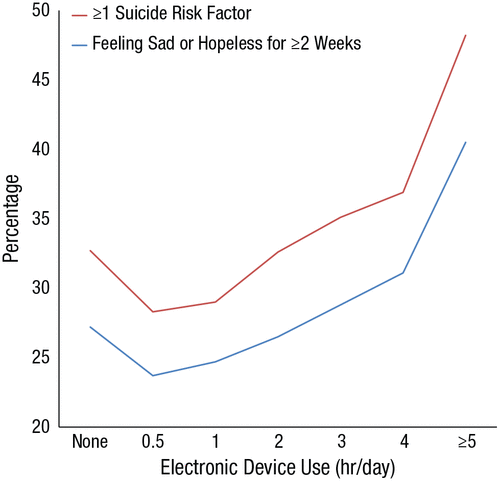Youth Mental Health Crisis & the Contribution of Screen Time
- US Surgeon General Murthy
2021 US Surgeon General’s Advisory Report: Protecting Youth Mental Health
"The challenges today’s generation of young people face are unprecedented and uniquely hard to navigate. The effect these challenges have had on their mental health is devastating".
Below is a cross-section of the research
that speaks to the extent of this crisis:
Center for Disease Control:
ER Visits for Youth Self-Harm

Pew Research Center:
7 in 10 U.S. teens said anxiety and depression are major problems among their peers in their community.
- Survey of 13-17 year olds, Fall 2018
US Surgeon General's 2021 Advisory: Protecting Youth Mental Health
Even before the COVID-19 pandemic, mental health challenges were the leading cause of disability and poor life outcomes in young people.
1 in 5 children ages 3 to 17 in the US have a reported mental, emotional, developmental, or behavioral disorder.
Between 2009 and 2019:
The proportion of high school students reporting persistent feelings of sadness or hopelessness increased by 40%.
The share of high school students creating a suicide plan increased by 44%.
Leading researchers have proposed and studied varying factors contributing
to this mental health crisis. Although there are varying opinions on some factors there is unanimous consensus on one:
the unsupervised, overuse of digital media, a.k.a.
the Third Parent.
CDC - Youth Risk Surveillance Survey 2009-2015:

Twenge, J. M., Joiner, T. E., Rogers, M. L., Martin, G. N. (2020). Considering All of the Data on Digital-Media Use and Depressive Symptoms: Response to Ophir, Lipshits-Braziler, and Rosenberg. Clinical Psychological Science, 8(2), pp. 379–383. https://doi-org.ezproxy.uvm.edu/10.1177/2167702619898179
J.D. Radesky, MD, Boston Medical Center:
Patterns of Mobile Device Use by Caregivers and Children During Meals in Fast Food Restaurants
Out of 55 caregivers eating with a child/children in a restaurant,
73% used devices during the meal, and the more absorbed the caregiver was in their devices, the harsher their repsonse to child misbehavior.
Janis Whitlock, Director, Cornell Research Program on Self-Injury & Recovery
If you wanted to create an environment to churn out really angsty people, we’ve done it. [Sure, parental micromanaging can be a factor as can school stress, but those are note the main drivers of the epidemic.] It’s that they’re in a cauldron of stimulus they can’t get away from, or don’t want to get away from, or don’t know how to get away from.

